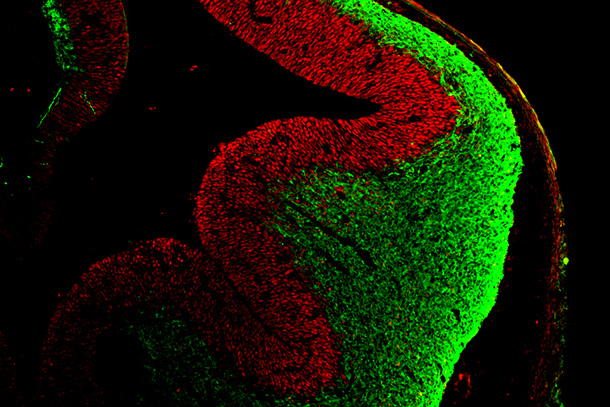Ryk has made the headlines by requiring a chaperone. But don’t assume that Ryk is a badly behaved celebrity — it’s actually a protein featured in a new study in the Proceedings of the National Academy of the Sciences (PNAS).
In the study, first authors Wen-Hsuan Chang from the USC Stem Cell laboratory of Wange Lu, PhD, and Si Ho Choi from the Dongnam Institute of Radiological & Medical Sciences (DIRAMS) in South Korea, along with their colleagues describe how Ryk and its chaperone contribute to the development of the brain’s cortex, which is the gray matter responsible for consciousness.
During cortical development, a part of Ryk called the intracellular domain (ICD) must be chaperoned into the nucleus of the stem cells that become neurons. Chang’s team discovered the identity of Ryk’s chaperone: a protein named Smek.
Smek not only chaperones Ryk into the nucleus, which contains the stem cell’s genes. Smek also works with Ryk to regulate the activity of key genes that transform stem cells into brain cells.
“Such studies not only help us understand the mechanisms of how stem cells become neurons, but also will be useful for us to develop therapies to treat neurological diseases and brain cancer,” said Wange Lu, associate professor of stem cell biology and regenerative medicine at the Keck School of Medicine of USC.
Additional authors include: Byoungsan Moon, Mingyang Cai, Jinlun Bai, Fan Gao, Ibrahim Hajjali, Daniel Campbell, and Leslie Weiner from USC; Jungmook Lyu from Konyang University in South Korea; and Zhongfang Zhao from Nankai University in China.
Ninety-five percent of this work was supported by $1,727,898 in U.S. federal funding from a National Institutes of Health grant (R01 NS067213-01A1). Five percent of the project was funded by $10,000 from two non-U.S. sources: a DIRAMS grant funded by the South Korean government (50590-2017), and the National Natural Science Foundation of China.
— Cristy Lytal


